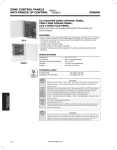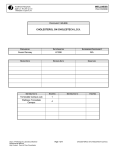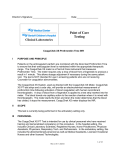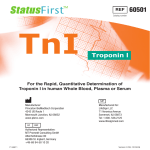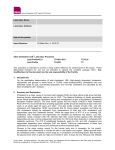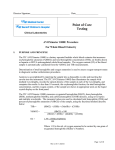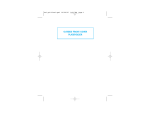Download Point Of Care Testing - University of California, San Francisco
Transcript
Director’s Signature:_______________________________ Date:________________ Point of Care Testing Clinical Laboratories CHOLESTECH LDX SYSTEM I. PURPOSE For the quantitative determination of total cholesterol, HDL cholesterol, triglycerides, and glucose may be performed on adult and pediatric patient samples. II. PRINCIPLE The Cholestech LDX System combines enzymatic methodology and solid-phase technology to measure total cholesterol, HDL cholesterol, triglycerides, glucose, ALT and AST. Samples used for testing can be whole blood from venipuncture or fingerstick (collected in a lithium heparin coated tube/ capillary tube). The sample is applied to a Cholestech LDX cassette. The cassette is then placed into the Cholestech LDX Analyzer. A unique system on the cassette separates the plasma from the blood cells. A portion of the plasma flows to the right and left sides of the cassette where it is transferred to reaction pads. The Cholestech LDX Analyzer measures the resultant color in all the reactions by reflectance photometry (the amount of light reflected from a solid surface. A brown magnetic stripe on each cassette contains the test names, instructions to the Analyzer for running the tests on the cassette, and calibration information for converting the color reading to analyte concentration in mg/dL for lipid profile and glucose. III. PERSONNEL Intended for use by clinical personnel who have received training and demonstrated competency in this procedure. In the hospital setting, this includes Clinical Laboratory Scientists, Registered Nurses, Nurse Practitioners, Physician Assistants, Physicians, Respiratory Tech.. In the ambulatory setting, this includes the aforementioned personnel as well as Medical Assistants, Licensed Vocational Nurses and other licensed Technologists. IV. REAGENTS AND EQUIPMENT A. Cholestech LDX Analyzer and power supply. B. Cholestech LDX test cassettes. Rev 2, Ver 1, 6/2013 1 of 11 1. Lipid Profile 2. Lipid Profile plus Glucose a. Cassettes must be stored in the sealed foil pouches. b. Cassettes may be used until the date printed on the pouch when stored in a refrigerator 2oC to 8oC (36oF to 46oF), or the cassettes may be stored up to 30 days at room temperature (9 – 30oC / 48 – 86oF). c. Once cassettes have been stored at room temperature they should not be returned to the refrigerator. Write the new expiration day on the cassette box. The new expiration date is the date the cassettes are placed at room temperature plus 30 days. d. Do not use cassettes beyond the printed expiration date, or cassettes that had been stored at room temperature for more than 30 days. e. Do not reuse cassettes. C. Cholestech LDX Mini-Pet Pipette or similar pipette with disposable tips – to place blood and quality control material into the cassette. A drop of 35 - 40 L (micro liters) is required. D. Optics Check Cassette – used to check the optical system of the Analyzer daily. Store at room temperature in the case provided. E. Quality control materials a. Cholestech LDX Multianalyte Control Level 1 and Level 2 Note: Controls are stored upright and refrigerated (2o - 8oC or 36o - 46oF). Unopened vials are expected to give stable results through the expiration date printed on the box. Opened vials are stable for 30 days refrigerated at 2o - 8oC or 36o - 46oF. Do not freeze. Minimize exposure to strong light. F. Ambient Room Temperature Thermometer- Temperature range: 20 oC to 31 oC (68oF to 88oF) G. Reagent Refrigerator- Temperature range: 2oC to 8oC (36oF to 46oF). H. Gloves I. Spring loaded safety lancets for finger stick J. Cholestech LDX Capillary Tubes (with lithium heparin anticoagulant): 35 L K. Cholestech LDX Capillary Plungers L. Biohazard Waste Container M. Kimwipes N. Alcohol swabs and gauze for clean puncture site V. SPECIMEN A. Sample volume: 35 - 40 uL whole blood from Lithium Heparin vacutainers or capillary tubes B. Whole blood collected in a Lithium Heparin vacutainers should be used within thirty minutes of draw C. Whole blood from a fingerstick (collected in a lithium heparin-coated capillary tube) for the Cholestech LDX test must be applied within 8 minutes of collection or the blood will clot. Rev 2, Ver 1, 6/2013 2 of 11 Performing a fingerstick: IMPORTANT: A warm hand and good blood flow from the puncture site are essential to collect a good capillary sample. 1. The patient should sit quietly for five minutes before the blood sample is collected. 2. Put a capillary plunger into the end of a Cholestech capillary tube with the red mark. 3. Choose a spot on the side of one of the center fingers of either hand. 4. Clean the site with an alcohol swab. Dry thoroughly with a gauze pad before pricking the finger. 5. Firmly prick the selected site with a lancet. 6. Squeeze the finger gently to obtain a large drop of blood. Wipe away this first drop of blood, as it may contain tissue fluid. 7. Squeeze the finger gently again while holding it downward until a second large drop of blood forms. Do not milk the finger. The puncture should provide a free-flowing drop of blood. 8. Hold the capillary tube by the end with the plunger at a slight descending angle to the drop of blood. Touch it to the drop of blood without touching the skin. The tube will fill by capillary action up to the black mark. Do not collect air bubbles. If it is necessary to collect another drop of blood, wipe the finger with gauze then massage again from base to tip until a large drop of blood forms. 9. Fill the capillary tube with 10 seconds. 10. Wipe off any excess blood from the finger and have the patient apply pressure to the puncture until the bleeding stops. D. Fluoride, oxalate, citrate and EDTA anticoagulants will interfere with the total cholesterol, HDL cholesterol, and triglyceride test and should not be used. E. Blood collection tubes whose stoppers are lubricated with glycerol should not be used for collection of specimens for the lipid profile plus glucose panels. F. Whole blood samples should be at room temperature for testing. Mix all samples by inverting gently 7-8 times before testing. NOTE: Patients should fast for 9 – 12 hours before the sample is collected. VI. QUALITY CONTROL A. Optic Check Cassette 1. Cholestech LDX Optics Check Cassette with known reflectance value is used to check the optical system of the Analyzer. The cassette should be stored at room temperature in its case and cannot be allowed to become wet, dirty, or scratched. 2. Optics check must be run each day of use. Rev 2, Ver 1, 6/2013 3 of 11 3. Optics check must be run after the Analyzer is serviced or moved. B. Temperature 1. Refrigerator temperature must be monitored and recorded on the temperature log daily. 2. Room temperature where the Cholestech is stored or used must be monitored and recorded on the temperature log daily. C. Liquid QC Controls 1. 2. 3. 4. 5. Run two levels of controls on each day of patient testing. Run two levels of controls on each new shipment of cassettes. Run two levels of control on each new lot of cassettes. Run two levels of control on each new box. Run controls if you think cassettes may not have been stored properly. Follow the instructions that come with the controls. Check the expiration date before use. Opened vials are stable for 30 days refrigerated. Verify that QC control results are in range before testing patients. 1. If controls are out of range for one or more analytes, then repeat the controls. 2. If repeat controls are still out of range, take primary instrument out of service and use back-up instrument. 3. Run liquid controls on the back-up instrument; if controls out of range, repeat. If controls fail again (possible cartridge problem), the out of control analyte(s) cannot be reported for that day. 4. Next day of use, open and run a new set of liquid controls. If controls are still out after two trials on both instruments, the cartridge is the suspected problem. The out of control analyte(s) should not be reported until a new lot of cartridges is obtained and shown to pass liquid quality control. Note: All opened reagent boxes and control vials must be dated and initialed upon opening. VII. PROCEDURE Note: Prior to patient testing, use two patient identifiers to verify patient identification and explain procedure to patient and/or family. A. Perform an Optics Check before running patient samples each day. The optics cassette is placed in the Analyzer and run as a specimen. The data printed for each of the 4 channels is then checked against the acceptable ranges printed on the cassette. Maintain a log sheet for the Optics Check cassette data. Rev 2, Ver 1, 6/2013 4 of 11 B. Perform two levels of liquid controls each day of patient testing, when a new box of cassettes is opened, and when cassettes may not have been stored properly. Record results on the QC log sheet. C. Let test cassette sit at room temperature for ten minutes. D. Remove the cassette from its pouch. Do not touch the black bar or the brown stripe. Hold the cassette by the short side only. Put the cassette on a flat surface. E. Press RUN. In a few seconds the screen will read: Selftest running Selftest OK F. The cassette drawer will open. The screen will read: Load cassette and press RUN G. Place the sample into the cassette well using a Cholestech LDX Capillary tube for fingerstick samples or the Cholestech Mini-Pet Pipette for controls or venous blood samples. Note: Fingerstick samples must be applied within 8 minutes of collection or the blood will clot. H. Keep the cassette flat after the sample has been applied. I. Place the cassette into the drawer of the Analyzer immediately. The black bar must face the Analyzer. The brown stripe must be on the right. J. Press RUN. The drawer will close. During the test the screen will read: [Test Name(s)] Test Running*** K. Put everything that touched the blood sample or control in a biohazard waste container. L. When the test is complete, the Analyzer will beep. The screen will read: [Test Name(s)]=### warnings M. When the results are outside the measuring range, the screen will read: Rev 2, Ver 1, 6/2013 5 of 11 [Test Name] >### or [Test Name] <### N. If there is a problem with the test, a message will appear on the screen. See the troubleshooting section of the Cholestech LDX User Manual if this happens. O. When the drawer opens, remove the cassette. Dispose of it in a biohazard waste container. Leave the analyzer drawer empty when not in use. P. Verifying patient identification, using two patient identifiers, attach patient preprinted “IDX” label to the printer data. Record the results in the patient’s medical record chart and give printed results to the Physician. Q. To run another cassette, press RUN. The screen will read: Load cassette and press RUN R. Repeat the test procedure. S. Otherwise, after 4 minutes a beep will sound and the screen will read: System Timeout RUN to continue T. If the RUN button is not pushed within 15 seconds the drawer will close and the screen will go blank. VIII. REPORTING OF RESULTS Results from the printer are given to the Physician as he/she sees the patient at the time of their appointment. The Cholestech LDX is programmed to report in mg/dl for lipid profile and glucose. Test results will show on the screen when the test is complete. Calculated results are shown after the DATA button is pressed. Results for out of control analytes are not reported. Note: Whenever a user identifies that an incorrect result has been reported, they are responsible for correcting/commenting the incorrect result (if possible), contacting the ordering provider, notifying them of the error, and documenting this notification, including the time and date, in the patient record. Rev 2, Ver 1, 6/2013 6 of 11 Expected Values Total Cholesterol Guidelines: Children and Adolescents (<20y/o): Acceptable <170 mg/dL Borderline 170-199 mg/dL High >199 mg/dL Adults (>19y/o): Desirable <200 mg/dL Borderline 200-239 mg/dL High >239 mg/dL HDL Cholesterol Guidelines: Acceptable >39 mg/dL Higher risk <40 mg/dL Lower risk >59 mg/dL Estimating the risk of atherosclerotic heart disease from the ratio of total/HDL Cholesterol is no longer recommended by many experts, who believe that HDL cholesterol is most useful when employed as part of the assay for LDL Cholesterol rather than by itself. Others believe that the ratio of total/HDL cholesterol may better predict coronary risk (high risk males:>6.0-7.0; high risk females: >5.6-6.0). Triglyceride Guidelines: The ATP 11 of the NHLBI has recommended these guidelines for fasting triglyceride levels: Desirable: <150 mg/dL Borderline high: 150-199 mg/dL High: 200-499 mg/dL Very high: >=500 mg/dL LDL Cholesterol Guidelines: Method: Calculated (Friedewald formula) Children and Adolescents (<20 y/o): Acceptable <110 mg/dL Borderline high 110-129 mg/dL High >129 mg/dL Adults (>19 y/o): Optimal for patients with CHD or CHD risk equivalent <100 mg/dL Desirable <130 mg/dL Borderline high-risk 130-159 mg/dL High-risk 160-189 mg/dL Rev 2, Ver 1, 6/2013 7 of 11 Very high-risk >=190 mg/dL NOTE: This estimate of LDL is not reliable if the triglycerides are 400 Glucose Guidelines: The American Diabetes Association has modified the criteria for fasting plasma glucose (FPG) and the diagnosis of diabetes mellitus. FPG 70 – 99 mg/dL FPG 100 – 125 mg/dL FPG >125 mg/dL normal fasting glucose impaired fasting glucose provisional diagnosis of diabetes Confirmed by one of the three methods below. The revised criteria for diagnosis of diabetes. Symptoms of diabetes plus casual plasma glucose concentration 200 mg/dL (11.1 mM/L). Casual is defined as any time of day without regard to time since last meal. (The classic symptoms of diabetes include polyuria, polydipsia, and unexplained weight loss). FPG >125 mg/dL (7.0 mM/L). Fasting is defined as no caloric intake for at least 8 hours. 2 hr post glucose load 200 mg/dL during an oral glucose tolerance test. The test should be performed as described by WHO (World Health Organization) using a glucose load containing the equivalent of 75g anhydrous glucose dissolved in water. Any of the above abnormal glucose levels must be confirmed, on a subsequent day, by any one of the three methods listed above. When screening for diabetes, any abnormal glucose results should be referred to a physician for further follow-up. Glucose Panic Value Reporting Panic Value ranges: Critical Adult/Pediatric <60 or >400 mg/dL Notify physician and if this is a new finding, send sample to Clinical Lab for confirmatory testing. Document actions taken. IX. MAINTENANCE A. Clean the outside of analyzer with a clean damp cloth. If necessary, a mild detergent or disinfectant (such as a 5% bleach solution) may be used. Do not Rev 2, Ver 1, 6/2013 8 of 11 immerse the Analyzer in water or other cleaning fluid. Do not use any abrasive cleanser. B. When necessary, clean inside the cassette drawer with a cotton swab moistened with water, a 70% isopropyl alcohol solution, a 5% bleach solution or disinfectant. Dry with a second (unused) cotton swab. X. LIMITATIONS Lipid Profile·Glucose A. The measuring range for total cholesterol is 100 - 500 mg/dL. Results outside this range will appear as <100 mg/dL or >500 mg/dL. B. The measuring range for HDL cholesterol is 15 - 100 mg/dL. Results outside this range will appear as <15 mg/dL or >100 mg/dL. C. The measuring range for triglycerides is 45 - 650 mg/dL. Results outside this range will appear as <45 mg/dL or >650 mg/dL. D. If the triglycerides are >400 mg/dL, the estimated LDL will not be calculated. E. If the total cholesterol, HDL cholesterol or triglyceride result is outside the measuring range, the LDL will appear as N/A. F. If the triglycerides are >650 mg/dL, the HDL result may not be accurate and will appear as N/A. (Results of 400 will affect the LDL calculated result.) Do not report LDL when triglyceride is 400. G. The measuring range for glucose is 50-500 mg/dL. Results outside this range will appear as 50 mg/dL or 500 mg/dL. H. The glucose test is specific for D-glucose. I. Other sugars that may be present in the blood do not react in the glucose test (i.e., fructose, lactose). J. Glucose tests done at altitudes above 5,000 feet may give low results. K. Samples with results outside of the measuring range must be sent to the Clinical Laboratory for testing. L. Performance of the Cholestech LDX System has not been tested on samples of lipid profile and glucose from newborns. M. The calculated LDL has a high bias compared to the UCSF Clinical Laboratory due to the high bias in total cholesterol and triglyceride results. In patients with LDL levels near the therapeutic decision points it is recommended that the LDL be confirmed in the central laboratory prior to making therapeutic decisions. XI. INTERFERING SUBSTANCES Lipid Profile·Glucose Rev 2, Ver 1, 6/2013 9 of 11 Some substances may cause false results with enzymatic tests. The substances listed below were tested for interference with the Lipid Profile/Glucose test. Less than 10% interference was seen at the levels shown. Substance Concentration (mg/dL) Hemoglobin 125.0 Gemfibrozil 15.0 L-Dopa 0.8 Bilirubin 5.0 Ascorbic Acid 1.0 Probucol 32.5 Urea 500.0 Nicotinic Acid 10.0 Fructose 30.0 Clofibrate 80.0 Uric Acid 15.0 Lovastatin 4.0 Creatinine 30.0 Dipyrone 10.0 Glutathione 1.0 Methotrexate 450.0 Cimetidine 7.5 Nitrofurantoin 2.0 Oxytetracycline 4.0 Gentisic Acid 0.5 Lactose 100.0 Methyldopamine 0.5 Cysteine 2.5 A. Hematocrits between 30-52% do not affect results. B. Blood collection tubes with glycerol should not be used for the triglyceride test. C. Hand creams and soaps with glycerol may cause falsely high triglyceride results. D. The triglyceride test measures triglycerides and free glycerol. Free glycerol usually is less that 20 mg/dL. E. There may be a 6 – 7% difference in the glucose levels of fingerstick and venous blood. F. Hematocrits between 30% and 50% do not affect results. XII. PRECAUTION A. Gloves must always be worn when working with patient and control samples. B. All blood samples and containers; capillary tubes and materials that have come in contact with blood should be handled as if capable of transmitting infectious disease and discarded into a biohazard waste container after use. XIII. REFERENCES A. Cholestech LDX User Manual B. UCSF Clinical Laboratory Manual C. Cholestech LDX Lipid Profile plus Glucose Product Insert. 2619en Rev. A 12/2012 D. Cholestech LDX Level 1 and Level 2 Control Product Insert ART10983B Rev. 0 350076-8 2007-03 E. Cholestech LDX Multi-Analyte Control Product Insert. ART14120 Rev. A 350456-6 2007-06 F. Alere San Diego, Inc., 9975 Summers Ridge Road, San Diego, CA 92121 www.alere.com Rev 2, Ver 1, 6/2013 10 of 11 Signature Manifest Document Number: SOP-0096 Title: Cholestech LDX_LipidGlucose Revision: 2 All dates and times are in Pacific Standard Time. Cholestech LDX procedure for review SR Sup Review Name/Signature Title Date Meaning/Reason Cynthia Ishizaki (024044224) POC SR SUP 21 Jun 2013, 11:30:45 AM Reviewed Med Dir Apprvl Name/Signature Title Date Meaning/Reason Tim Hamill (023335003) PA CB MED DIRECTOR 26 Jun 2013, 01:33:57 PM Approved Rev 2, Ver 1, 6/2013 11 of 11











